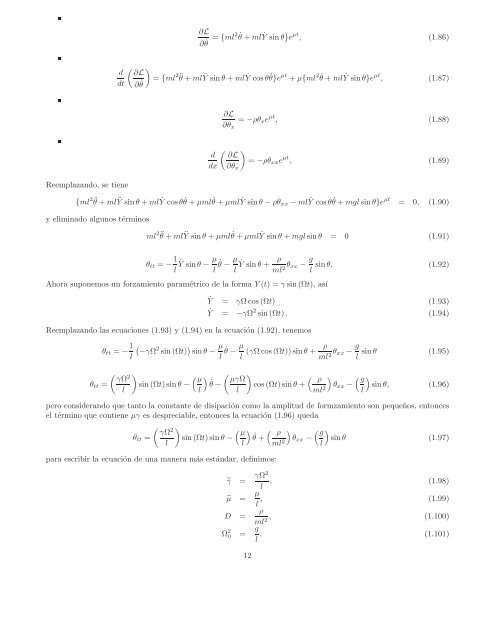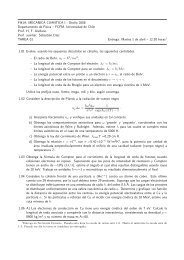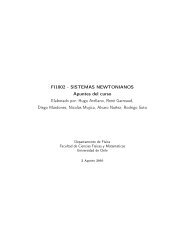universidad de chile dinámica de dominios en sistemas forzados ...
universidad de chile dinámica de dominios en sistemas forzados ...
universidad de chile dinámica de dominios en sistemas forzados ...
You also want an ePaper? Increase the reach of your titles
YUMPU automatically turns print PDFs into web optimized ePapers that Google loves.
d<br />
dt<br />
Reemplazando, se ti<strong>en</strong>e<br />
<br />
∂L<br />
∂ ˙ θ<br />
∂L<br />
∂ ˙ θ = {ml2θ ˙ + mlY˙ µt<br />
sin θ}e , (1.86)<br />
= {ml 2¨ θ + ml ¨ Y sin θ + ml ˙ Y cosθ ˙ θ}e µt + µ{ml 2 ˙ θ + ml ˙ Y sin θ}e µt , (1.87)<br />
∂L<br />
= −ρθxe<br />
∂θx<br />
µt , (1.88)<br />
<br />
d ∂L<br />
= −ρθxxe<br />
dx ∂θx<br />
µt . (1.89)<br />
{ml 2¨ θ + ml ¨ Y sin θ + ml ˙ Y cosθ ˙ θ + µml ˙ θ + µml ˙ Y sin θ − ρθxx − ml ˙ Y cosθ ˙ θ + mgl sin θ}e µt = 0, (1.90)<br />
y eliminado algunos términos<br />
ml 2¨ θ + ml ¨ Y sinθ + µml ˙ θ + µml ˙ Y sin θ + mgl sin θ = 0 (1.91)<br />
θtt = − 1<br />
l ¨ Y sinθ − µ<br />
l ˙ θ − µ<br />
l ˙ Y sin θ + ρ<br />
ml2θxx − g<br />
sinθ. (1.92)<br />
l<br />
Ahora suponemos un forzami<strong>en</strong>to paramétrico <strong>de</strong> la forma Y (t) = γ sin (Ωt), así<br />
Reemplazando las ecuaciones (1.93) y (1.94) <strong>en</strong> la ecuación (1.92), t<strong>en</strong>emos<br />
˙Y = γΩ cos(Ωt) (1.93)<br />
˙Y = −γΩ 2 sin(Ωt). (1.94)<br />
θtt = − 1 2 µ<br />
−γΩ sin (Ωt) sin θ −<br />
l<br />
l ˙ θ − µ<br />
ρ<br />
(γΩ cos(Ωt))sinθ +<br />
l ml2 θxx − g<br />
sin θ (1.95)<br />
l<br />
2 γΩ<br />
<br />
µ<br />
<br />
θtt = sin (Ωt)sin θ − ˙θ<br />
µγΩ<br />
<br />
ρ<br />
− cos(Ωt)sin θ +<br />
l<br />
l l<br />
ml2 <br />
g<br />
<br />
θxx − sinθ, (1.96)<br />
l<br />
pero consi<strong>de</strong>rando que tanto la constante <strong>de</strong> disipación como la amplitud <strong>de</strong> formzami<strong>en</strong>to son pequeños, <strong>en</strong>tonces<br />
el término que conti<strong>en</strong>e µγ es <strong>de</strong>spreciable, <strong>en</strong>tonces la ecuación (1.96) queda<br />
2 γΩ<br />
<br />
µ<br />
<br />
θtt = sin (Ωt)sin θ − ˙θ<br />
ρ<br />
+<br />
l<br />
l ml2 <br />
g<br />
<br />
θxx − sin θ (1.97)<br />
l<br />
para escribir la ecuación <strong>de</strong> una manera más estándar, <strong>de</strong>finimos:<br />
γ = γΩ2<br />
, (1.98)<br />
l<br />
µ = µ<br />
, (1.99)<br />
D =<br />
l<br />
ρ<br />
, (1.100)<br />
ml2 Ω 2 0 = g<br />
, (1.101)<br />
l<br />
12





